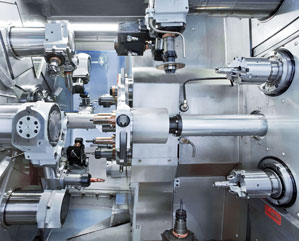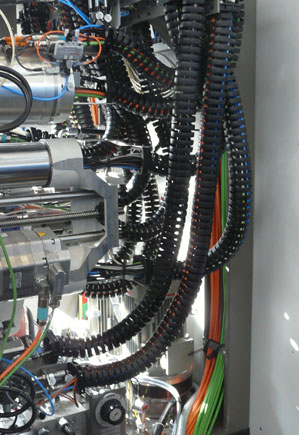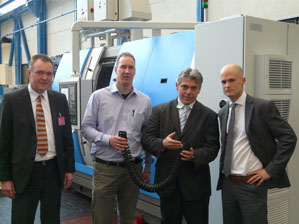energy chains® in CNC multi-spindle lathes
Greater freedom of motion at very high cycle rates
CNC lathes from Schütte are known throughout the world as the gold standard for productivity, and – particularly so – for flexibility. With up to nine spindles and associated machining modules, they have the capability of performing a host of machining steps in a single setup. During the machining process, each orientation must be supplied with energy, signal technology, as well as coolant and drive cooling along the outside diameter and the front face of the workpiece. For the type series SCX, Schütte relies on the triflex® R 3D energy chains from igus® to accomplish these tasks.
Manufacturers of complex turned components want to maximize the number of machining steps processed in a single setup, since this cuts down on time and cost. The SCX type series from Schütte accomplishes this objective in the best possible manner. Even in their basic configuration, the multi-spindle lathes have six primary spindles, including associated compound and transfers slides for workpieces, which can be processed almost completely from the primary workpiece side.
The concept can be upgraded by one or three back spindles to address machining requirements that also call for extensive machining on the secondary workpiece side. And since the spindles and machining modules can also work in the C and Y axis, users of SCX CNC lathes have entirely new levels of freedom for machining highly complex workpieces.
advanced energy and media supply
One of the underlying design features of the SCX series is that the design engineers banished everything from the workspace that is not immediately involved in creating the workpiece: drive and guide elements, lubricant and coolant lines, as well as power cables. Nonetheless, each turret-head and each spindle must of course be supplied with coolant media, energy and signals. The media, energy and signal supplies are subject to substantial requirements: In addition to axial travel, they must also perform a high-speed rotational motion.

Schütte's SCX type series is the gold standard for multi-spindle CNC lathes.

The base configuration of the SCX has six spindles. Up to nine spindles are available to machine front and back sides.
The approach taken by the design engineers to solve these challenges becomes apparent when the machine panels to the right or the left of the workspace are opened. While the workspace impresses with its extremely clean design in order to provide the user with the greatest possible configuration freedom and straightforward setups, the drive and spindle cavities are densely packed with drive units, spindle sleeve guides and the moving energy supplies to the machining modules. Dr.-Eng. Guido Spachtholz, Design Engineering Manager, Multi-spindle CNC Lathes: "Each specific orientation must be supplied with a variety of media, such as coolant or lubricant for the tooling stations, as well as energy" “
The application places extreme demands on the service life of the energy chain: "Executing achievable cycle times of 5 to 10 seconds results in 5,760 cycles per shift –and a corresponding number of movements by the energy chain. " This means: the first 100,000 cycles are completed after only 17.3 shifts. Based on 24 hour/5 day operation, a full year would result in more than 4.5 million cycles! And Schütte would never be satisfied with a component that only has a one-year service life: The machines are known throughout the world for their long service lives.
From the very beginning, an energy chain was intended for the energy supplies to the machining modules and spindles. But the originally selected model was unable to meet Schütte's high demands. Design engineering manager, Dr. Spachtholz: "When the first units were being produced, our colleagues from the assembly department gave us the feedback that the energy chains® were difficult to fill. We then started looking for an alternative." “
The solution was found not far from Schütte' s manufacturing facility, which is ideally located directly along the Rhein River and only a few kilometers away from Cologne's inner city: The triflex® R energy chain from the Cologne-based energy chain experts, Igus, was originally developed for demanding six axes robot applications in rough industrial environments, e.g. for axial and rotational chain movements.
The "R" in the product designation stands for "round", and with a construction kit of more than 100 individual components, the triflex® R can be precisely configured for any application. In spite of its tensile strength, the three section 3D chain can be filled with ease –down to the last centimeter. Dipl.-Eng. Markus Rudat, who managed the project design engineering effort: "Even media lines that have a fairly large cross-section, such as coolant lines, can be effortlessly clipped into the chain." “
Consequently, Schütte's assembly staff was quickly won over by the new e-chain®. And the design engineers favored the compact design, which is of particular importance given the limited space availability in the machine. The triflex® R provides more space for lines than the previously used model, and since it does not need a steel cable due to its accurately manufactured ball joints, it is also highly flexible.
It was of particular significance to Schütte's design engineers that the chain performed at least as well as the previously used competitive model with respect to service life. Dipl.-Eng. (FH) Markus Kogelmann, Igus Sector Manager for machine tools, took the Schütte tests in stride: "The triflex® R is fundamentally designed for a very long service life, even under the most demanding loads." “

Each individual machining orientation is supplied with media, energy and signals.

Schütte created standardized attachments to fasten the triflex® R chains to the spindles.

Satisfied with the result of the collaboration: Igus Sales Consultant, Hans-Josef Kleinert, Dipl.-Eng. (FH) Markus Rudat, Design Engineer, Multi-spindle CNC Lathes at Schütte, Dipl.-Ing. (FH) Markus Kogelmann, igus® Sector Manager, Machine Tools, Dr.-Ing. Guido Spachtholz, Design Engineering Manager, Multi-spindle CNC Lathes at Schütte (from left to right).
This was confirmed in trials as well as in actual production deployments, which have provided experience in the meantime: The energy chains® are able to handle high loads – this in spite of the fact that the chains must execute long travels at high speeds and perform reaching stroke and swivel motions with each tool cycle. Even the oil fog of the frequently aggressive coolant media has no negative impact on the chain's service life.
But the Schütte engineers did a considerable amount of detailed design engineering work to create the best possible conditions for a long service life. Markus Rudat: "We partially use two chains for one machining orientation, where one performs the rotating motion and the other the axial motion. We defined several standardized options for the attachment." “
The SCX type series employs the triflex® R-Type TRL 60, were the L stands for "light" and the number indicates the interior diameter of 60 mm. The enclosed configuration of the base version triflex® R was disregarded because the drive locations remain free of chips. Markus Rudat has defined several chain lengths, which are custom filled depending on the customer's specific configuration of the assembled SCX. The staff also benefits from the easy handling of the chain during service work: Lines can be easily replaced, as is also the case for individual chain links. Given all these characteristics, the flexibility and long service life of the triflex® R are able to meet the expectations Schütte has of its own machines, and which are appreciated by users around the world.
More than 100,000 products available! Delivery and consultation Mon-Fri from 7am-8pm and Sat from 8am-12pm!